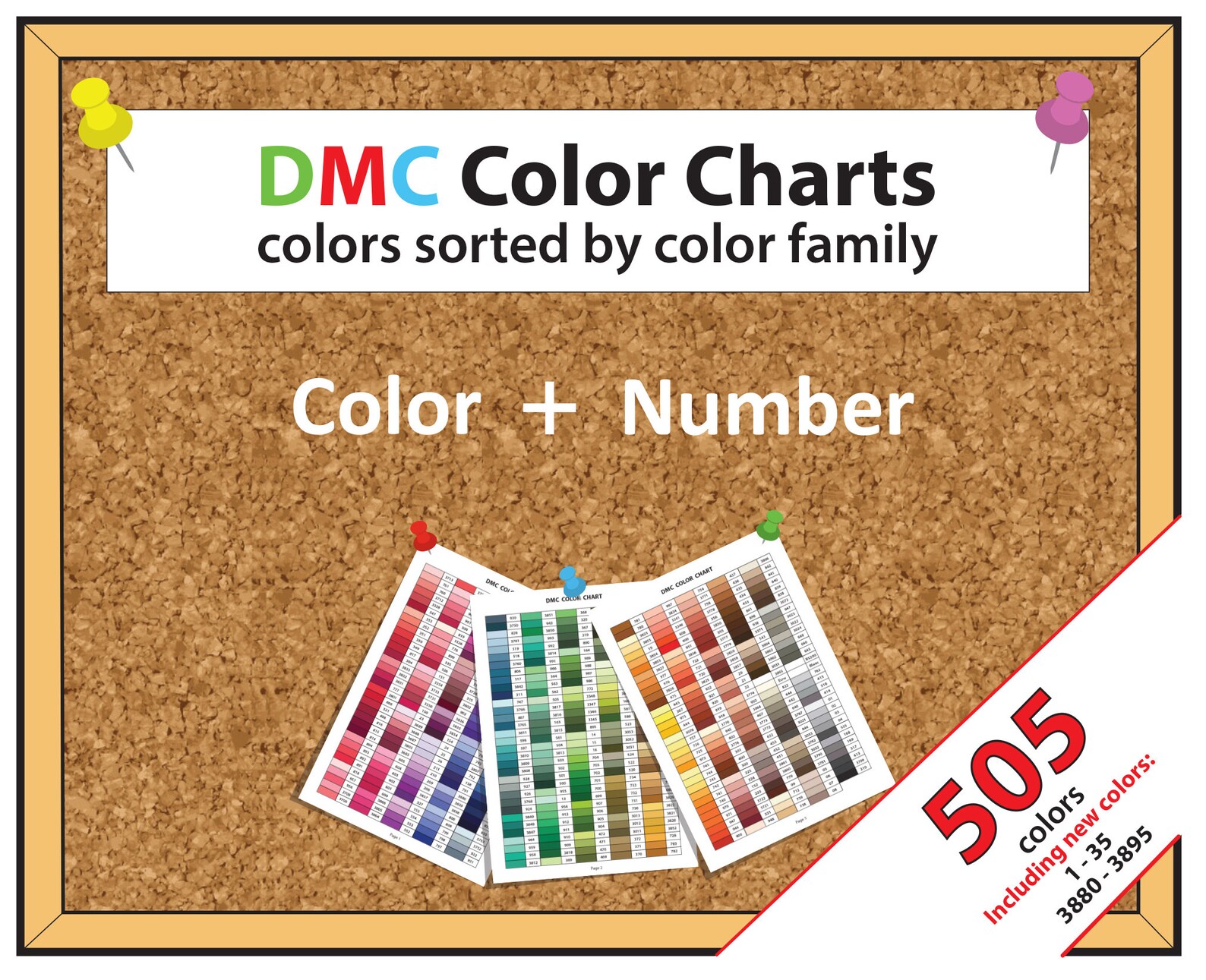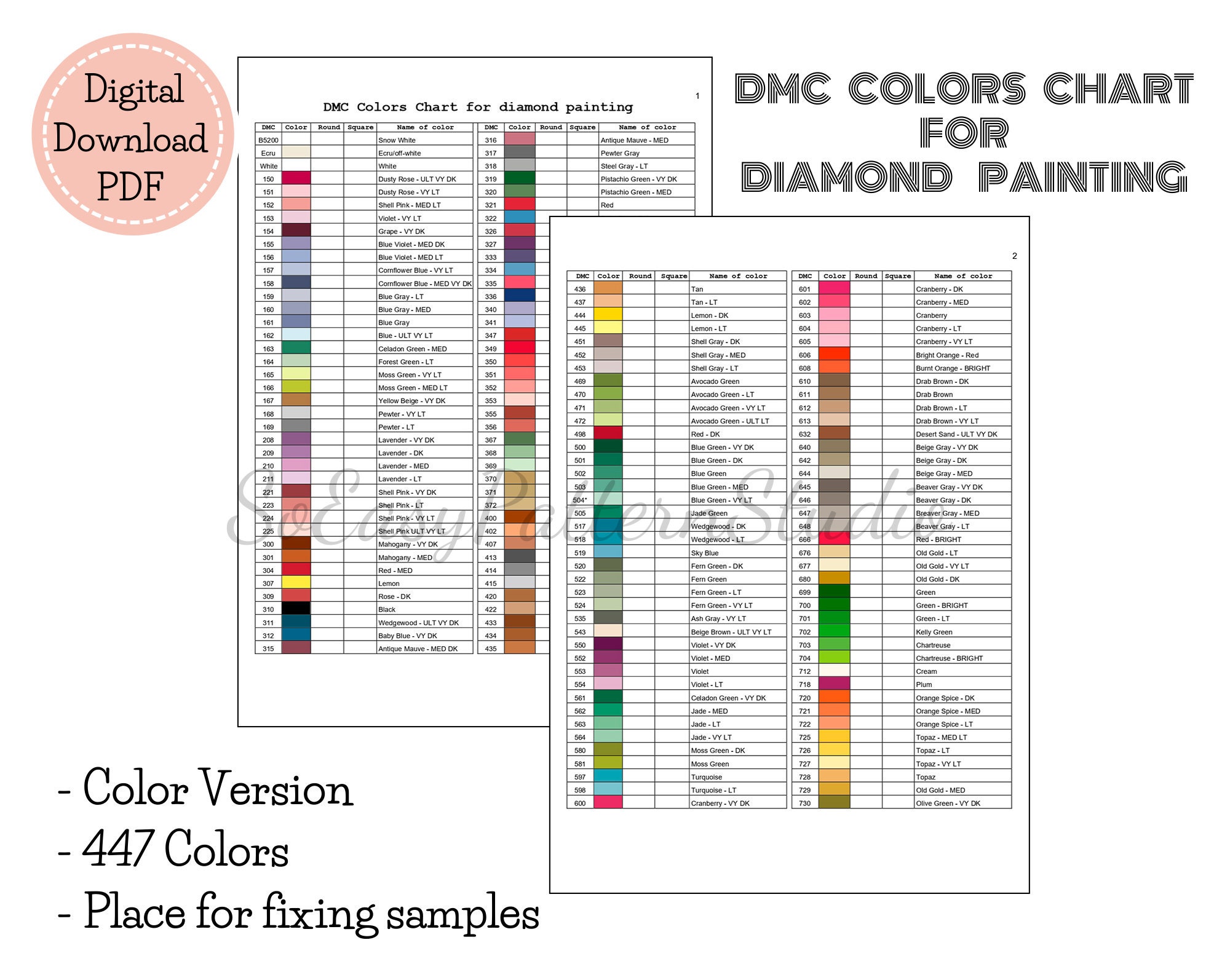Are you a cross-stitching or embroidery enthusiast looking for the perfect thread colors? Look no further! In this comprehensive guide, we delve into the world of free printable DMC color charts. Get ready to explore the benefits, understand the codes, find and download printable charts, and learn how to utilize them for your craft projects.
Let’s take your thread selection skills to the next level!
Introduction to DMC Color Chart
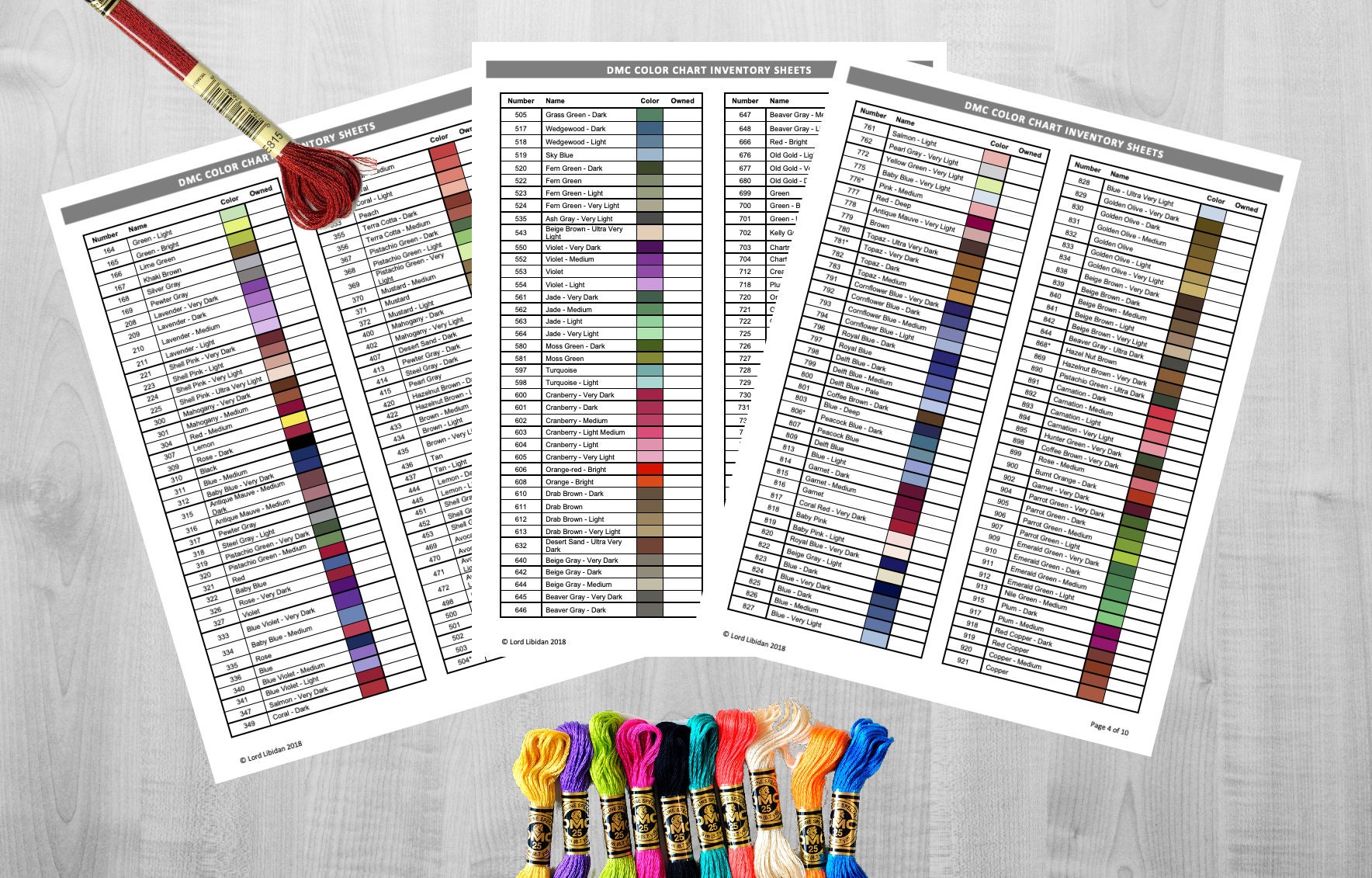
A DMC Color Chart is a reference guide that provides a comprehensive list of colors for cross-stitching or embroidery projects. It is a valuable tool for crafters to ensure accurate color selection when working on their projects.
The Importance of Having a Color Chart
Having a DMC Color Chart is essential for cross-stitching or embroidery projects for several reasons. First and foremost, it allows crafters to accurately match the desired color of the pattern with the available thread colors. This ensures that the final result closely resembles the original design.Additionally,
a color chart helps crafters in organizing their threads efficiently. With a color chart, they can easily identify and locate the specific thread colors needed for each section of the pattern. This saves time and prevents confusion during the stitching process.
The Benefits of Using a DMC Color Chart
Using a DMC Color Chart offers several benefits for selecting thread colors. Firstly, it provides a wide range of color options, allowing crafters to find the exact shade they desire for their project. This ensures that the final piece reflects their artistic vision.Furthermore,
a DMC Color Chart categorizes the thread colors in an organized manner. It typically follows a numerical system, making it easy for crafters to navigate and locate the desired colors. This systematic organization simplifies the process of finding and selecting thread colors, enhancing the overall stitching experience.
Organization and Categorization of a DMC Color Chart
A DMC Color Chart is organized and categorized based on the numerical system assigned to each thread color. The chart usually includes a list of numbers, with each number representing a specific thread color. These numbers are accompanied by the corresponding color swatch, allowing crafters to visually identify the colors.The
numerical system of the DMC Color Chart follows a logical order, with similar colors grouped together. This arrangement facilitates the process of finding matching or complementary colors for a particular design. Crafters can easily locate the desired color by referring to the assigned number and visually comparing it to the color swatches provided.Overall,
a DMC Color Chart is an indispensable tool for cross-stitching or embroidery enthusiasts. It helps ensure accurate color selection, efficient thread organization, and a seamless stitching experience.
Understanding the DMC Color Chart Codes
The DMC Color Chart uses alphanumeric codes to identify specific thread colors. These codes consist of a letter followed by a number, such as “B5200” or “E718.” Each code represents a unique color within the DMC thread collection.
These codes serve several purposes in the identification and organization of thread colors. Firstly, they provide a standardized system for categorizing and referencing the vast range of colors available. With over 500 colors in the DMC collection, the codes help to streamline the process of locating and selecting the desired thread color for a project.
The letter in the code represents the color family to which the thread belongs. For example, “B” stands for blue while “E” represents brown. This allows users to quickly identify the general color group of a thread based on its code.
It also aids in organizing and sorting threads by color family for easy reference.
The number in the code provides further specificity within the color family. It distinguishes different shades and variations of a particular color. For example, “5200” represents a bright white thread, while “718” represents a dark red-brown. This level of detail ensures that even subtle differences in thread shades can be accurately identified and matched.
Here are some examples of DMC Color Chart codes for different thread colors:
B5200
Bright white
E718
Dark red-brown
310
Black
744
Yellow
995
Dark electric blue
It’s important to note that the DMC Color Chart may also include special codes or variations for specific threads. These codes typically indicate unique characteristics or finishes of the thread, such as metallic or variegated threads. These special codes help users easily identify and differentiate these specialized threads from the standard solid-color threads.
Understanding the DMC Color Chart codes is essential for anyone working with DMC threads. They provide a standardized system for identifying and organizing thread colors, making it easier to select the right shades for embroidery or other projects. By familiarizing yourself with the codes and their meanings, you can navigate the vast array of DMC thread colors with confidence and precision.
Finding and Downloading a Free Printable DMC Color Chart
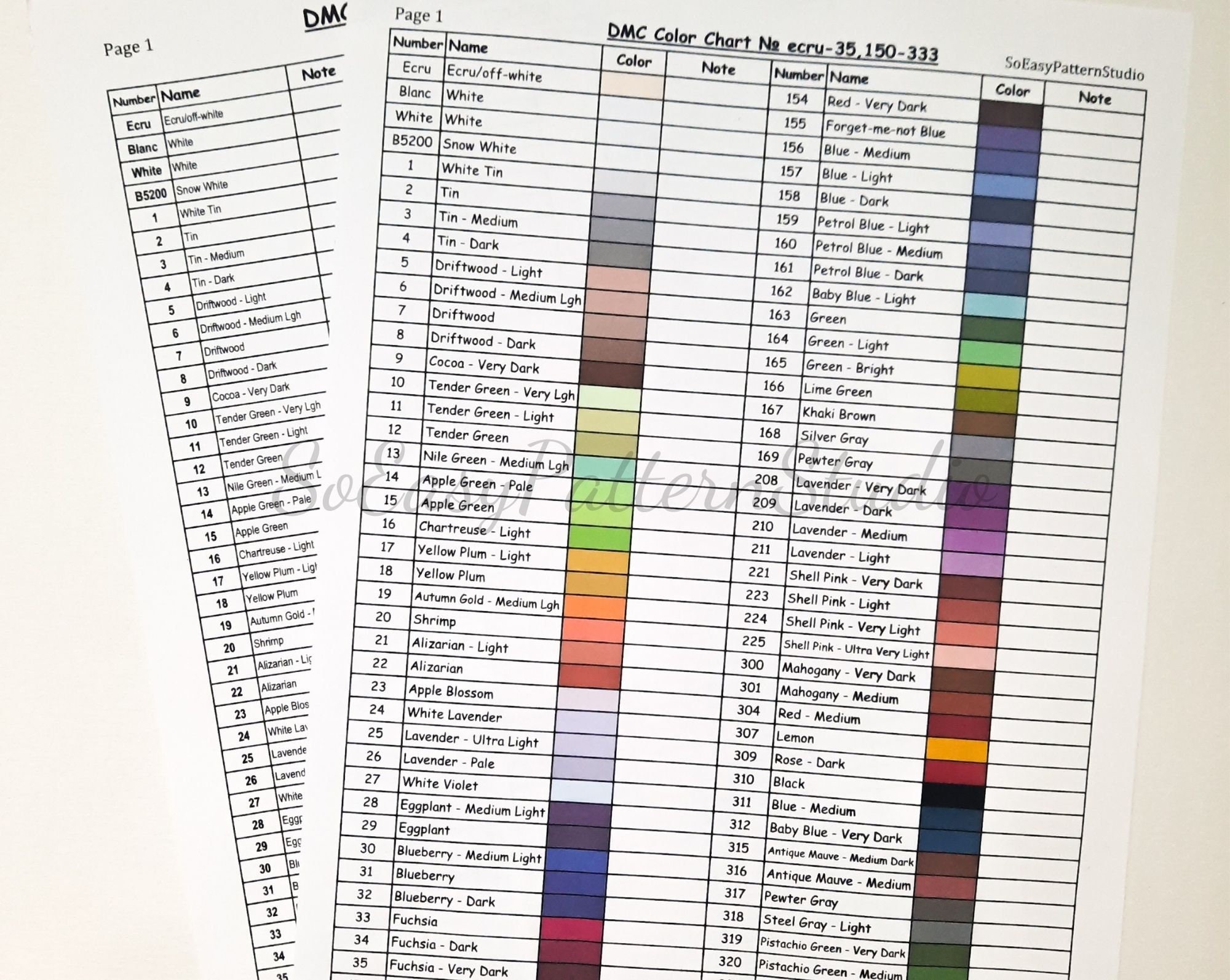
Finding a free printable DMC Color Chart online is easy and convenient. There are several reliable sources where users can access and download these charts for their embroidery projects. Here are some options:
1. DMC Website
The official DMC website is a trustworthy source to find and download a printable DMC Color Chart. Visit the website and navigate to the “Color Charts” section. Look for the option to download a printable version of the color chart.
The chart provided by the DMC website is accurate and up-to-date.
2. Embroidery Blogs and Websites
Many embroidery blogs and websites offer free printable DMC Color Charts. These charts are often created by experienced embroiderers who share their knowledge and resources with the community. Look for reputable embroidery websites or blogs and search for their free resources section.
You will likely find a printable DMC Color Chart available for download.
Advantages of Using a Printable Version of the DMC Color Chart
Using a printable version of the DMC Color Chart offers several advantages:
Portability
A printed color chart can be easily carried around, allowing you to reference it whenever and wherever you need it.
Accessibility
Having a printed copy of the color chart ensures that you always have access to the color codes, even if you don’t have an internet connection.
Convenience
With a printed chart, you can quickly compare and select the colors you need without having to switch between screens or devices.
Organization
By printing and organizing the color chart, you can easily track and manage your thread collection.
How to Download and Print a DMC Color Chart
Follow these step-by-step instructions to download and print a DMC Color Chart:
- Visit a reliable source that offers free printable DMC Color Charts, such as the DMC website or embroidery blogs.
- Locate the download link for the printable color chart and click on it to initiate the download.
- Save the downloaded file to your computer, ensuring that you remember the file’s location for easy access.
- Open the downloaded file using a PDF reader or image viewer software.
- Adjust the print settings according to your preferences. You may choose to print the color chart in color or black and white.
- Load your printer with high-quality paper that is suitable for printing images.
- Click the print button to start printing the color chart.
- Once the printing is complete, check the quality and accuracy of the printed color chart.
Ensuring Accuracy and Quality of the Printed Color Chart
To ensure the accuracy and quality of the printed DMC Color Chart, follow these tips:
Use a high-quality printer
Are you looking for a first day of kindergarten printable? Look no further! We have a great resource for you. With this first day kindergarten printable , you can easily prepare your child for their big day at school. This printable includes fun activities and coloring pages that will help them get excited about starting kindergarten.
It’s a great way to introduce them to the school routine and make their first day memorable. So, don’t wait any longer, click the link and get your printable now!
A printer with good color reproduction capabilities will produce more accurate results.
Check the printer settings
Make sure the printer settings are optimized for printing images or graphics.
If you’re searching for a fun and educational activity, dot to dot printables are the way to go. You can find a wide range of dot to dot printable free resources online. These worksheets are not only entertaining but also help improve your child’s hand-eye coordination and number recognition.
They are perfect for rainy days or as a quiet activity during travel. You can find dot to dot printables with various themes, such as animals, vehicles, or even famous landmarks. So, why not give it a try? Click on this dot to dot printable free link and start connecting the dots!
Use high-quality paper
Choose a paper type that is specifically designed for printing images or graphics. This will ensure that the colors appear vibrant and accurate.
Verify the colors
Compare the printed color chart with the digital version on your computer screen to ensure that the colors match.
Keep the printed chart in a safe place
Store the printed color chart in a protective sleeve or folder to prevent damage and ensure its longevity.By following these steps and tips, you can easily find, download, and print a free DMC Color Chart that is accurate and of high quality.
Utilizing a Printable DMC Color Chart for Craft Projects
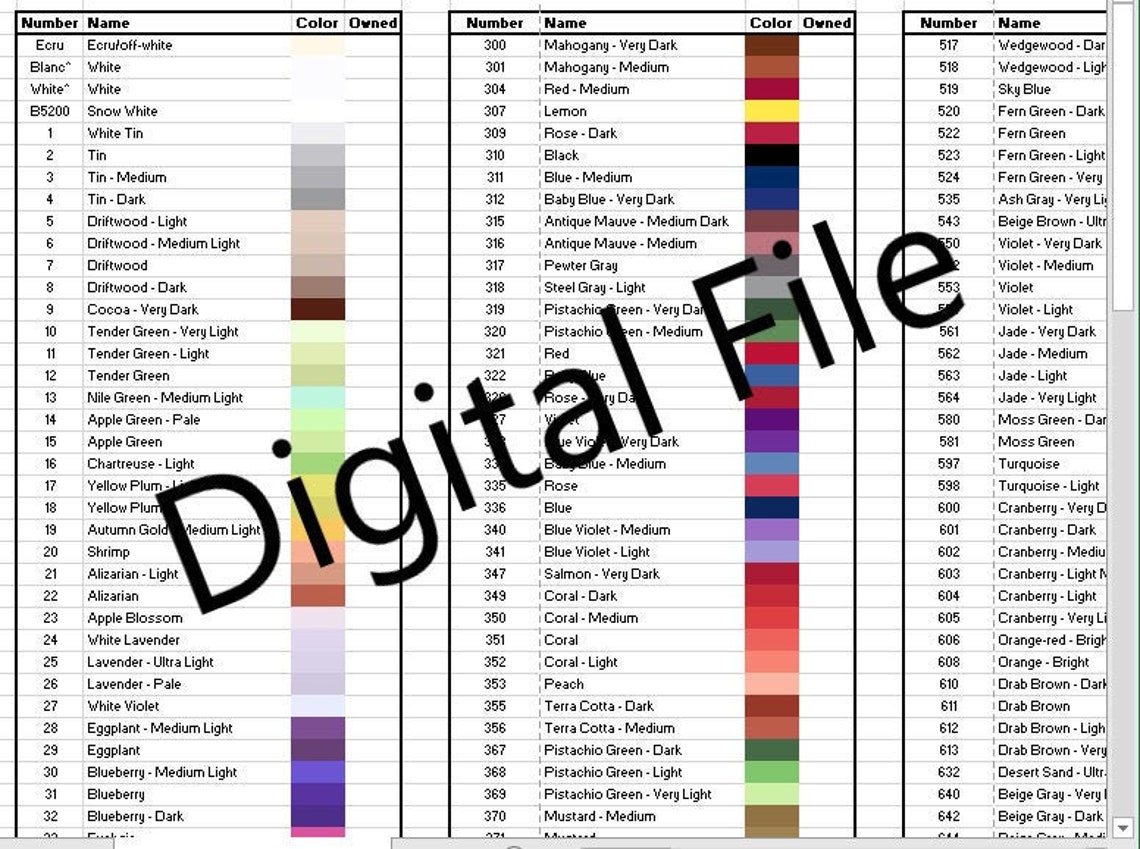
A printable DMC Color Chart is a valuable tool for crafters who work with embroidery or cross-stitch projects. It allows you to easily select thread colors and ensure accuracy in your designs. Whether you are a beginner or an experienced crafter, using a printable DMC Color Chart can greatly enhance your crafting experience.
Selecting Thread Colors
When starting a new project, one of the first steps is selecting the appropriate thread colors. A printable DMC Color Chart provides a visual reference of all the available colors, making it easier to compare and choose the right shades for your design.
By referring to the color chart, you can ensure that your finished project matches your vision.
- Example: Let’s say you are working on a floral embroidery project. By using a printable DMC Color Chart, you can easily identify the shades of green for the leaves, the different colors for the flowers, and any other details that require specific thread colors.
- Example: If you are creating a cross-stitch pattern of a landscape, the color chart can help you select the appropriate shades for the sky, trees, water, and other elements in the design.
Tips and Techniques for Effective Use
To make the most of a printable DMC Color Chart, consider the following tips and techniques:
- Labeling: Print out the color chart and label each color with its corresponding DMC code. This will make it easier to identify the colors when working on your project.
- Color Matching: Use the color chart to match the thread colors with the colors in your design. You can place the thread directly on the color chart to compare and find the closest match.
- Color Blending: The DMC Color Chart also includes codes for blended colors. This allows you to create unique shades by combining two or more threads. The chart provides guidance on the proportions of each thread to use for blending.
Limitations and Considerations
While a printable DMC Color Chart is a helpful tool, there are some limitations and considerations to keep in mind:
- Screen Accuracy: The colors on a printed chart may differ slightly from the actual thread colors. It is recommended to use the printed chart as a reference and compare it to the actual threads for accurate color selection.
- Thread Availability: The DMC Color Chart includes a wide range of colors, but not all colors may be readily available in stores. Check the availability of the thread colors you need before starting your project.
Organizing and Storing a DMC Color Chart: Free Printable Dmc Color Chart

Keeping the DMC Color Chart organized and easily accessible is essential for any embroidery or cross-stitch enthusiast. It allows for quick reference and ensures that you can easily find the thread colors you need for your projects. Here are some suggestions on how to store and protect the printed color chart as well as alternative methods for organizing it digitally.
Storing and Protecting the Printed Color Chart
- Consider using a binder or folder specifically designed for organizing papers. This will help keep the color chart neat and prevent it from getting damaged or lost.
- If you prefer a more portable option, you can laminate the color chart or place it in a clear plastic sleeve. This will protect it from spills and tears, and you can easily carry it with you wherever you go.
- Label the binder or folder with the name “DMC Color Chart” to make it easy to identify among your other craft supplies.
- Store the color chart in a location that is easily accessible, such as a craft drawer or shelf. Avoid placing heavy objects on top of it to prevent any creasing or bending.
Organizing the Color Chart Digitally
- Scan or take a high-quality photo of the printed color chart and save it on your computer or mobile device. This allows for easy access and eliminates the need to carry a physical copy.
- Create a separate folder on your computer or device specifically for the DMC Color Chart. This will help keep it organized and prevent it from getting mixed up with other files.
- If you prefer a more interactive experience, you can use embroidery software or apps that provide digital versions of the DMC Color Chart. These often come with additional features such as color matching and project planning.
Keeping the Color Chart Updated, Free printable dmc color chart
- DMC occasionally introduces new thread colors, so it’s important to keep your color chart updated. Check the DMC website or other reliable sources regularly for any new additions.
- If you’re using a digital version of the color chart, make sure to download any updates or patches provided by the software or app developers.
- Consider creating a separate section in your binder or folder for new thread colors. This will make it easier to incorporate them into your existing color chart.
- Label any new thread colors with the corresponding DMC code to ensure accuracy when referencing them in your projects.
